A love of transparent houses designed by modern masters inspired Jacob and Melissa Brillhart’s new home, just a stone’s throw from the Miami River in southern Florida. “We were enamored by the typical American glass pavilion,” says Jacob.
A few years back, he was attending undergraduate classes at Tulane University in New Orleans before moving on to the Graduate School of Architecture at Columbia, N.Y. Melissa studied at the University of Virginia, with graduate work at the University of Miami.
Today, they’re the principals of Brillhart Architecture, a successful Miami practice whose output clearly demonstrates their appreciation for three contemporary icons of the past century: Mies van der Rohe’s Farnsworth House in Plano, Ill., Philip Johnson’s Glass House in New Canaan, Conn., and – closer to home – Paul Rudolph’s Cocoon House in Sarasota, Fla.
“We love the way Rudolph made it vernacular and put louvers on it,” says Jacob. “He said: ‘I want to do a glass house, too, and make it tropical.’ ”
The couple also studied the vernacular of the rustic Florida dogtrot, with sleeping areas on one side, living areas on the other and an open, covered porch sandwiched in between.
In their unique Brillhart House, they’ve taken cues from all of these examples, merged them together and made them work in a verdant tropical landscape on a tight half-acre lot in one of Miami’s oldest platted neighborhoods.
They cleverly set the shutter-covered, plantation-like home back 120 feet from the street, aligning it with an aging bungalow to the west and creating a cinematic approach through a tropical jungle.
“You park in a little forest that blocks the view of the house and the street,” says Jacob. “There’s a walkway of oolitic limestone quarried from the Florida Keys. It’s in two-inch slabs that are four feet by four feet, but I purposely took a sledgehammer to them and broke them up so they look much more organic.”
The couple planted the forest after a trip to Fairchild Tropical Botanic Garden in Coral Gables, Fla., whose 83 acres are dedicated to conserving native plants. “We walked through and wrote down all the plants we wanted to surround us at home,” Melissa says.
They chose stoppers, bay rums, crabwoods and palms, among other species, to complement the site’s 100-feet-tall climbing figs and the soaring 70-feet-tall Washingtonian palms next door.
Just eight-to ten-feet tall when planted three years ago, the young trees are now almost 15 feet high and act as effective screens.
Exit the faux forest and you’re on an axis perpendicular to an oblong house that’s elevated five feet above ground level.
Step up eight stairs made of ipe, walk through louvered doors of western red cedar and you’re perched on a porch that’s neither inside nor out, sheltered in dark brown cedar louvers contrasted by a natural blond cypress floor.
“You sort of have a series of filters,” Jacob says. “There are the trees in the forest, then the louvers for privacy, air flow and light – and then the thermal glass that filters the air, the light and the temperature.”
The home features 100 feet of uninterrupted glass – 50 feet spanning the length of both the front and back – with four sets of sliding glass doors that allow the house to be entirely open when desired.
Eight-foot overhangs form two shaded porches – south-facing at the front and north-facing to the rear – and reduce heat gain during the summer. Burlap drapes provide privacy for anyone inside. Both eastern and western exposures are paneled in ipe for opacity.
Clearly, the architects have thought carefully about their 1,500-square-foot glass and wood home, adapting it to its natural landscape and manipulating its physical environment.
“You walk through a forest and then a clearing, then up into the house and then through it and back into the landscape,” Jacob says. “That’s how we packaged it up.”
“Conceptually, anyway,” Melissa agrees.
The home’s interior layout takes its dogtrot antecedents seriously. There’s a central foyer with a light and spacious kitchen straight ahead, two en suite bedrooms on the immediate left and, to the right, a 30- by 18-foot living space.
White oak flooring echoes the front porch’s blond cypress floor. Cabinets in the kitchen and bathrooms – as well as doors and their frames throughout – are American cherry, collected by Jacob’s father for the past 20 years.
Besides a small dining area next to the kitchen, the main sitting area is centered in front of a log fireplace. While not an essential feature in Florida, it provides welcome heat in cooler months and anchors the room visually.
An open bookcase – filled with personal tomes, objets d’art from the couple’s travels and a unique original model of the home, encased in melted amber soap and illuminated atop a light stand – spans the entire width of the living space.
Behind the sofa lies another box containing a design model that didn’t come to fruition. The Brillharts were chosen as one of five finalists to design an art installation for New York City’s iconic MoMA PS1 art institution earlier this year.
Their multisensory Drones’ Beach submission, which sought to bring a beach environment into an urban setting, didn’t win but it garnered valuable national exposure and further cemented their reputation as architects on the ascendant.
Where Paul Rudolph’s modernist Cocoon House struggled with limitations inherent in mid-20th-century materials, Brillhart House harnesses the many advantages of modern technology.
“Today, glass is insulated so you can live in a glass house and not have a huge energy bill,” Jacob says. “The new technology in glass and insulation makes a building like this doable.”
To achieve $70 monthly energy bills, they used 9/16th-inch thermal glass that’s hurricane-proof (and also burglar-resistant) along with spray-foam insulation.
“You can get incredible thermal values,” says Jacob. “It’s a thin, sexy profile and you get R30 [a high rating of the window’s ability to resist heat traveling through it] – the technology of materials has come so far.”
The architects not only collaborated on the home’s design and landscape – Jacob was initially more involved in structural issues, Melissa with landscape and interiors – but on its construction too. “We were hands-on,” Melissa says. “We were the general contractors.”
“We also did a lot of the work ourselves, but we brought in an electrician and a plumber,” Jacob adds. “We did the millwork on the louvers, the ipe and the interiors.”
The entire house sits on three concrete stem foundation walls, arranged parallel and 15 feet apart. Six steel beams were laid on top of these walls, creating the home’s substructure.
“Air can move through underneath,” says Jacob. “And it’s also easy to fix a pipe because you just crawl around under there and do what you need to do.”
Visually, the house seems to melt into its environment as it rises above the tropical floor. “It feels like it’s floating,” Melissa says. And like its 20th-century precedents, it looks like it too.
For more information, visit brillhartarchitecture.com.
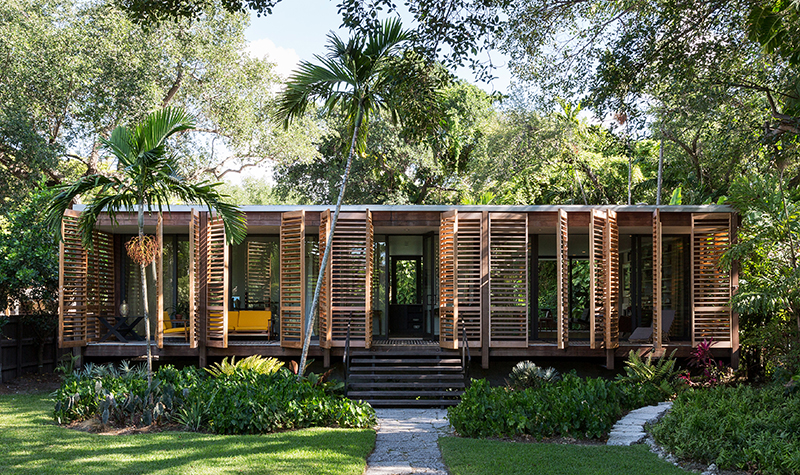  |
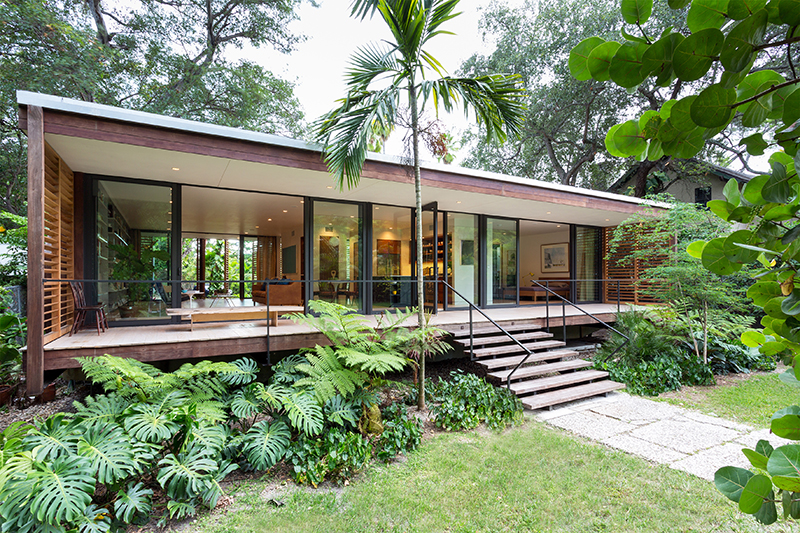  |
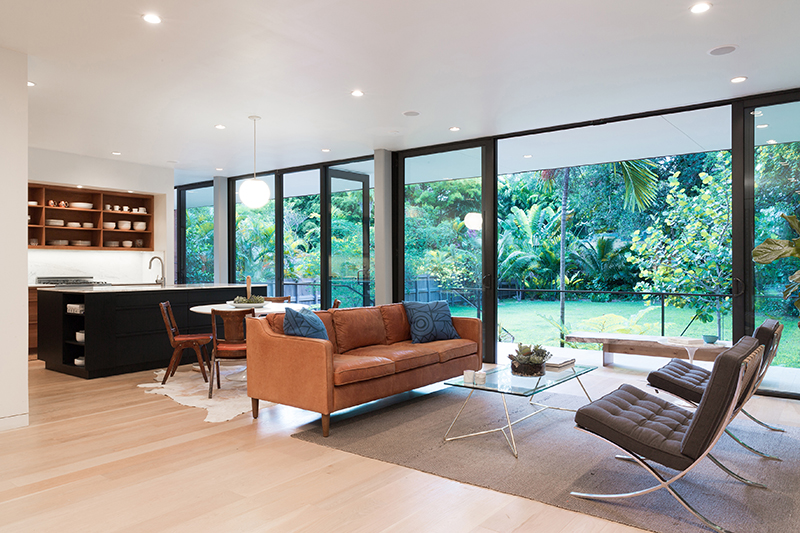  |
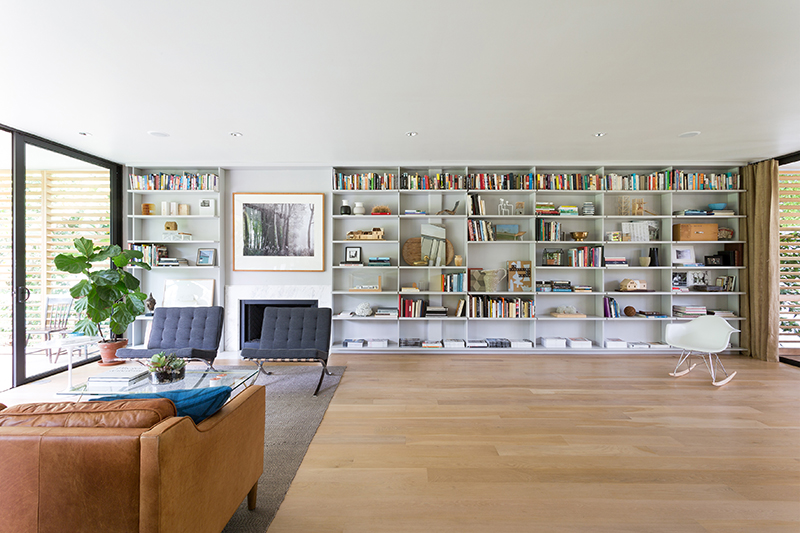  |
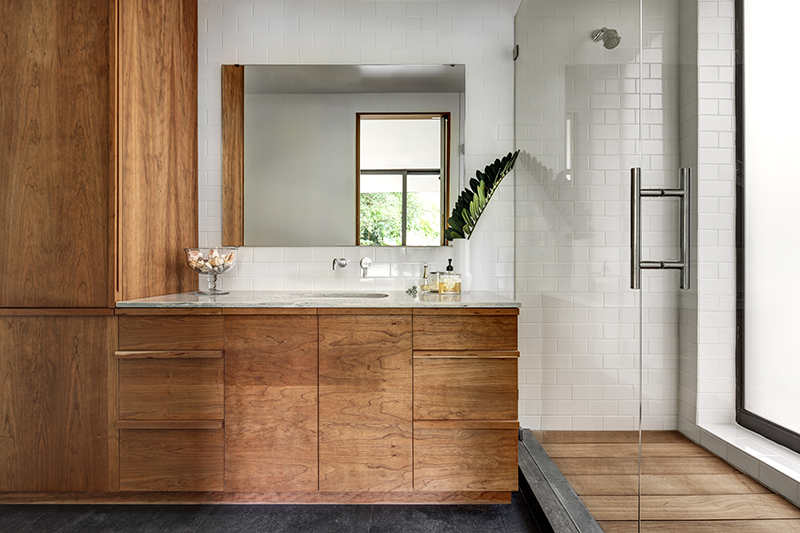  |
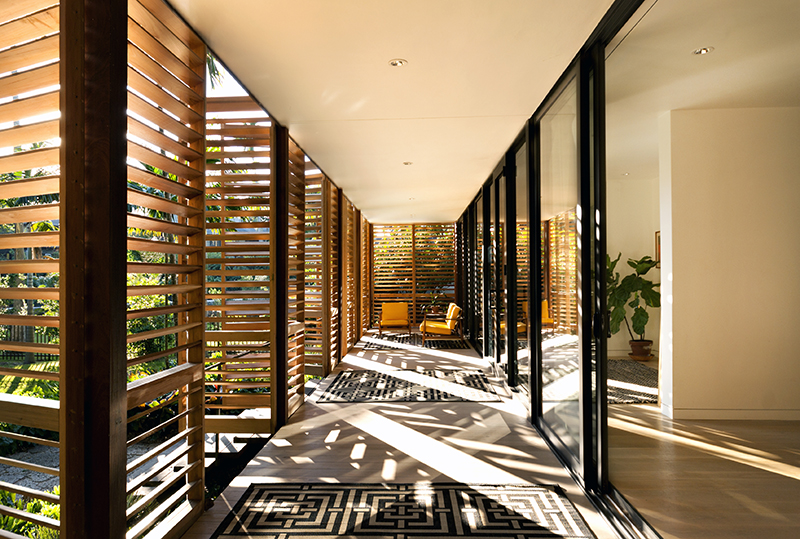  |
Image Credits: Photos by Claudia Uribe, Bruce Buck, and Stefani Fachini.

